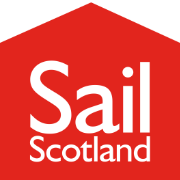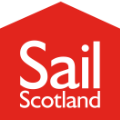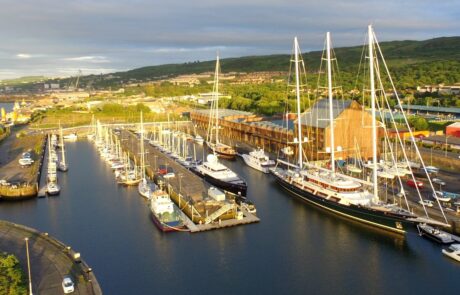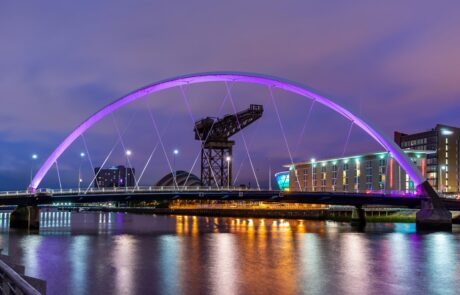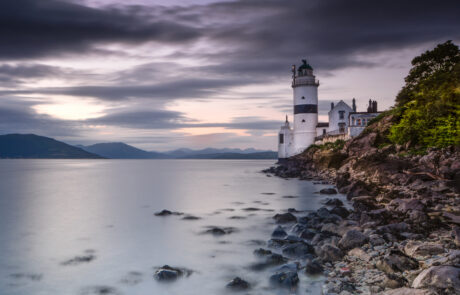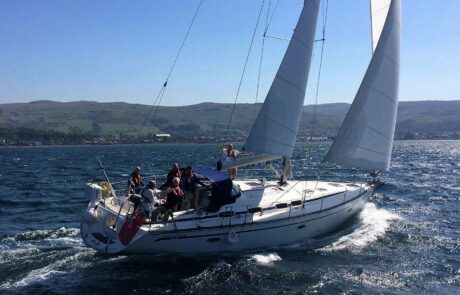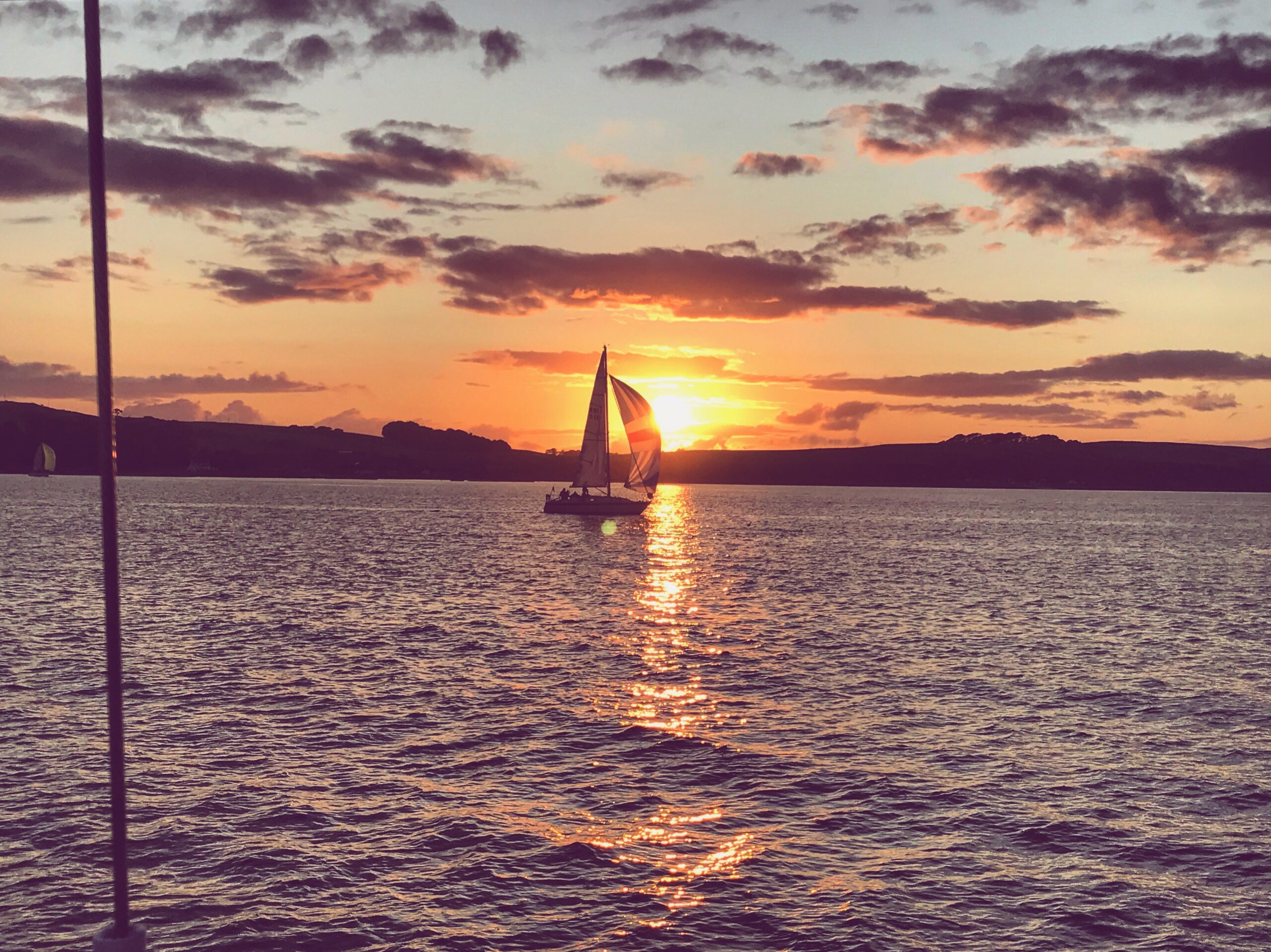The Firth of Clyde
The Firth of Clyde
ONCE THE GATEWAY TO SCOTLAND’S INDUSTRIAL HEARTLAND, the Firth of Clyde is a renowned sailing destination blessed with excellent facilities. Stretching from the bustling city of Glasgow to charming islands, the River Clyde runs into sea lochs extending all the way to the Highlands.
The Firth of Clyde is a wonderfully sheltered cruising area with ten of the best large marinas in the UK which can accommodate several thousand boats, and there’s a host of marine services close at hand. At the heart of this diverse region is the exciting, vibrant city of Glasgow, while a world away from the hustle and bustle you can enjoy a leisurely exploration of peaceful islands and delightful seaside resorts.
The main Clyde marinas for resident and charter vessels are the Troon (Sailing Today’s UK Marina/Harbour of the Year 2017), Ardrossan, Largs (Coastal Marina of the Year 2017), Kip, Rhu, Holy Loch and James Watt Dock, while Fairlie Quay is particularly popular for winter storage and has been developed as a centre for maintenance. All are easily accessible by public transport and the increase in low-cost air travel has encouraged many yacht owners who live elsewhere to keep their vessels in Scottish marinas. More recent marina developments are now well established at the award-winning Portavadie Marina and Spa in Loch Fyne and Port Bannatyne on the Isle of Bute.
The Clyde is more than just a convenient playground; it is also the perfect starting point for cruises to more distant places. Visiting boats arriving from the south or Ireland may choose to visit the new marina at Stranraer, where shore-side facilities have been upgraded as part of the EU-funded Sail West project, before venturing further north into the firth itself.
The first fully serviced marina on the Firth of Clyde can be found at Troon. From there, a popular route is north-west through the beautiful Kyles of Bute to the Crinan Canal and then to the Argyll coast and islands, Skye and the Outer Hebrides. Heading south-west past Arran and round the Mull of Kintyre, perhaps calling at Sanda or Campbeltown, is a passage best undertaken in good weather. It leads to the southern Isles of Gigha, Islay and Jura or alternatively across the North Channel to Rathlin Island, Ballycastle and Glenarm.
There’s also a range of options for those who do not want to leave the firth. This rich cruising ground has moderate tidal streams and ranges, well-marked hazards and, apart from a few popular spots, relatively few other boats. The ‘harbour full’ sign has yet to reach Scottish waters!
One of the most popular destinations is Tarbert, on the western side of lower Loch Fyne. It was once lined with skiffs and fishing boats from one side of the harbour to the other, and the fishing heritage is an important part of the personality here. The fleet remains active today though it has, to some extent, given way to visiting and resident yachts of all types and sizes. The marina provides pontoon berthing for over 200, small chandlery and good shore-side facilities. It is a picturesque village where the illuminated remains of Tarbert Castle overlook the harbour at night, while the nearby shops, bars and restaurants are acknowledged attractions too.
Flotilla visits are welcome to Tarbert, and it is a favourite with sailing clubs for musters and rallies. It also hosts the Clyde Cruising Club’s Scottish Series each spring. This attracts upwards of a hundred competitive yachts from far and wide for a long weekend of racing in the waters of Loch Fyne where, although it has few hazards and gentle tides, the variable wind patterns offer the racing sailor great challenges.
In contrast to the tradition of Tarbert, just 3nm across Loch Fyne is the modern resort at Portavadie. The marina here has almost 250 berths and a full range of facilities, including a luxury spa with outdoor infinity pool overlooking the loch. As well as the leisure centre there is a small chandlery and gift shop, and restaurant or café dining is available on site.
From there, venture north past Ardrishaig and the entrance to the famous Crinan Canal, before continuing to the more remote destinations on Loch Fyne. Otter Ferry and Strachur, both with visitor moorings and landing pontoons, are popular spots for sailors to step ashore for lunch, while various anchorages can be found in between at Loch Gair, Minard Bay and Lachlan Bay – home to another castle ruin and hidden gem restaurant. Deeper into upper Loch Fyne you can admire the pretty tourist town of Inveraray, and at the very head of the loch is the well-known Oyster Bar – which provides visitor moorings for those intrepid sailors who make it all the way!
Other destinations with pontoon berthing are Campbeltown, Ardrishaig and Rothesay, plus a new facility at Girvan on the Ayrshire coast. These are ideally placed for the cruising yachtsman. Campbeltown is close to the Mull of Kintyre and a good port of call arriving from the south, while Ardrishaig is the eastern terminus of the Crinan Canal. Girvan lies midway between the harbours of Stranraer and Ayr, while Rothesay, capital of the beautiful Isle of Bute, is a traditional favourite.
At Lamlash on Arran or in the Kyles of Bute more traditional landing methods – anchoring and going ashore by dinghy – can be found. In many spots, hotels and communities have laid moorings for visitors, while smaller pontoon facilities have been installed to assist with landing a dinghy at some locations. These are sometimes free for patrons or a nominal charge may be made.
Arran is often called ‘Scotland in Miniature’ as it has almost all the elements of the whole of Scotland including mountains, castles, beaches, golf courses, a brewery and a distillery. You can call at Brodick, Lamlash or Lochranza and in each place you will find visitor moorings, with the additions of a landing slip at Lamlash and a fine new pontoon at Lochranza.
The Kyles of Bute is one of the prettiest open-water passages in Britain. Its fjord-like channels, or kyles, wind between heather-clad hills, past sleepy holiday villages and through groups of islands. What’s more, every half-mile or so there is an anchorage to stop for lunch or for the night. Ashore, the village pubs and restaurants are renowned for their good food and pleasant ambience. Here you will meet fellow sailors enjoying themselves and locals with a tale to tell of past seafaring exploits.
Loch Fyne may be the deepest and longest at around 40 miles, but it’s not the only sea loch worth mentioning. If you’re thinking of getting off the beaten track, the Clyde’s lochs will take you deep into Scotland’s mountains. The scenery is magnificent, the sailing straightforward and, although there are around 5000 boats on the Clyde, you will easily find a spot of solitude.
Loch Long is exactly as it says on the chart, and strikes deep into the highest mountains in southern Argyll, known locally as the Arrochar Alps, and this offers a good opportunity to ‘bag a Munro’. Loch Goil is a branch off Loch Long to the west and has two attractive destinations: Carrick Castle, near the mouth of the loch, and Lochgoilhead, at its head.
The last sea loch before entering the River Clyde is the Gare Loch. This was one of the first areas to embrace leisure boating in Scotland and is home to one of the oldest yacht clubs in Britain, the Royal Northern and Clyde Yacht Club, at Rhu. The marina at Rhu is also an ideal stopover to explore Scotland’s first national park and its breathtaking scenery.
The Clyde, after years of decline, has come to life again and there are potential stopping places on the way up the river at Bowling and Clydebank before reaching Glasgow harbour. Here there are pontoons on either side of the river at the BBC building which are free to use but should be booked in advance.
You can get lots of information on all aspects of sailing in the Firth of Clyde from the Clydeport Leisure Marine Guide, freely available or to download from www.clydeport.co.uk in particular, it deals with the passage up the river to Glasgow. This is a fascinating city to visit, packed with history, culture and entertainment events. Now you can see a great city and live in comfort on your own boat.
One of the benefits of being a tourist by boat in the Clyde area is the relative ease in visiting different places that are often separated by tens of miles of road, or only linked by air or ferry. In a sailing or power boat these journeys are simple and as a result are very satisfying. This is a world-class tourist area, with attractions ranging from archaeology and castles to distilleries and superb restaurants. It is almost as interesting being ashore as it is fun being afloat!
Not only is Scotland known for the quality of its cruising waters, it has an enviable reputation for hosting excellent racing and cruising events throughout the year. These vary in size and competitiveness, but all share the common theme of superb sailing combined with sociable post-event relaxation.
The premier event of the year is the Scottish Series (www.scottishseries.com) which is recognised as one of the UK’s top yachting regattas. It is the largest Scottish yachting event and entrants travel from all over the world to take part.
It is the only international-standard competition for IRC yachts in Scotland, but also features courses for less competitive yachts and one-design classes, at a time of the year perfect for honing performance for the summer season regattas. While the event has historically been seen as being suitable for ‘serious racers’, the organisers do offer restricted sail classes as well as passage races which have proved popular with families and less experienced crews. The regatta is based in the picturesque waters of Loch Fyne with the berthing and regatta centre located in the stunning natural harbour village of Tarbert on the Mull of Kintyre. The event, which takes place in May, is organised by the Clyde Cruising Club.
The Firth of Clyde also plays host to numerous other race events throughout the season, some of which are scheduled to encourage boats taking part in the Scottish Series to prolong their stay over three or four weekends. The Scottish Series is preceded by the Pelle P Kip Regatta and is followed by the Old Pulteney Mudhook IRC Scottish Championships at Helensburgh. Towards the end of the season the major events are the Clydeport Largs Regatta Week in August and the GSS North Clyde Regatta in September.
The larger yacht clubs host their own series throughout the year, with local classes such as the Piper also being catered for, and the season ends with the Autumn Points Race Series hosted by Kip and Largs marinas during September and October. Full details are available from Clyde Cruising Club or the Clyde Yacht Clubs Association (www.cyca-online.org.uk), which also have their own handicapping system for non-IRC boats.
Every October Kip Marina hosts Scotland’s Boat Show, the third largest in UK and now the UK’s largest brokerage (pre-owned) boat show – with an unrivalled selection of new and used boats on view, attracting approximately 16,000 visitors from far and wide.
One of Scotland’s smallest regions but with the warmest welcome, Inverclyde sits at the mouth of the River Clyde. Made up of three thriving coastal towns; Port Glasgow, Greenock and Gourock and the villages of Kilmacolm & Quarrier’s Village to the East and Inverkip & Wemyss Bay to the West.
The area has a history and heritage rich in shipbuilding and seafaring dating back to the 1500’s which has left its mark throughout the region.
These days, it offers a broad range of sports and leisure facilities, both indoors and outdoors, with excellent marina facilities at Kip Marina and James Watt Dock as well as boating and yacht clubs.
Kip Marina situated on the firth of the Clyde in Inverkip – Kip Marina has 600 protected pontoon berths available 24 hours a day seven days a week for vessels up to 24m.
James Watt Dock – situated in the heart of Greenock offers around 170 pontoon berths for craft ranging in size from 7m to 100+m within a historic dock setting with full deep water access and Marina facilities.
Step ashore to find a range of shops, bars and restaurants to explore and enjoy.
Regulars to Kip Marina will be familiar with the Chartroom offering fabulous food and drink with views of the Marina. A short walk to the village and you will find The Inverkip Hotel which has a roaring fire, a cosy bar and a warm welcome, serving excellent food.
Gourock has a number of unique shops and galleries offering a lovely boutique shopping experience such as The Pirate and Bluebell, Treasured and Coorie In. As well as plenty of places to eat including the Spinnaker Bar & Hotel, the Cafe Continental and River, all with stunning views of the River Clyde.
If you fancy a swim in the Clyde but it’s too cold, from May – Oct the Gourock Outdoor Pool is open, sitting right along the Clydeside and has heated, filtered sea water.
Greenock is the main town in the area with easy access from James Watt Dock where you will find the main shopping centre, the larger supermarkets where you can restock and transport links to Glasgow and beyond. There are also a number of restaurants and bars for an evening ashore.
Find out more about Inverclyde and what’s on offer at Discover Inverclyde.
